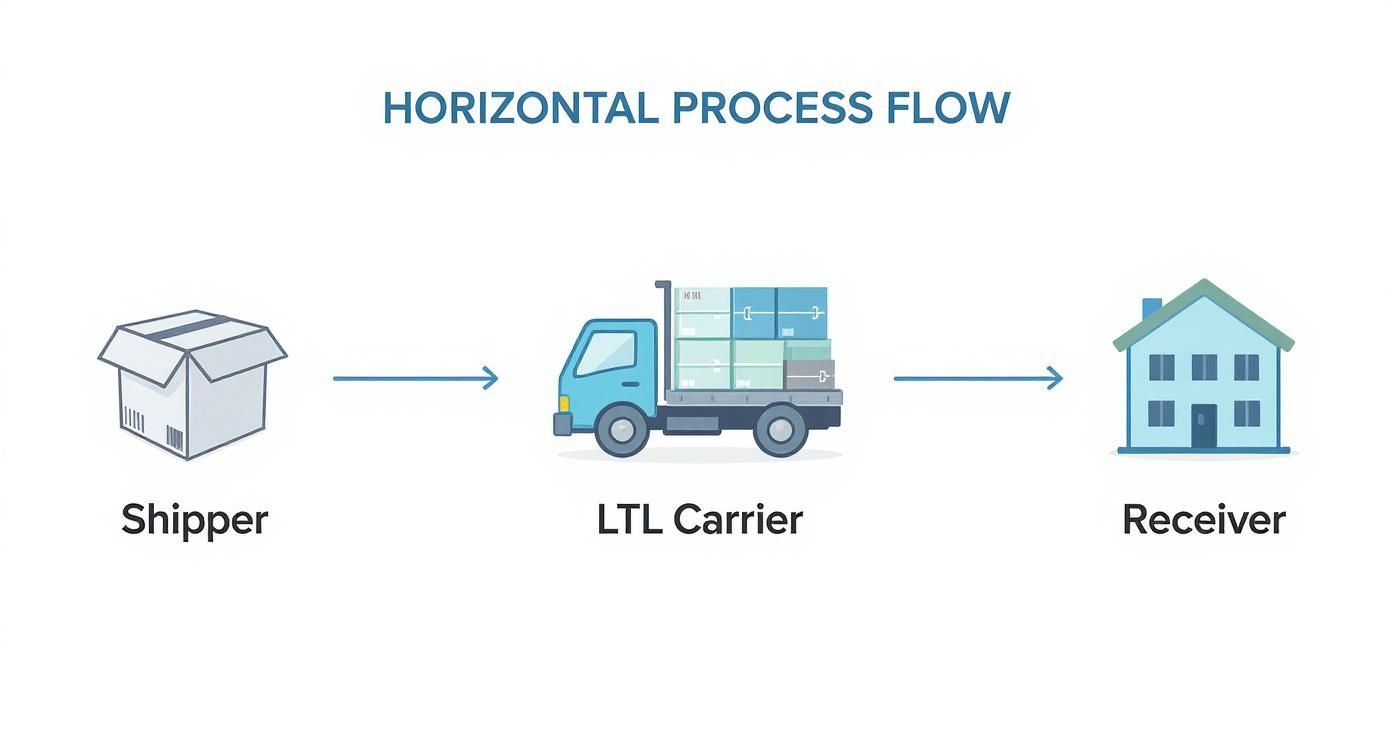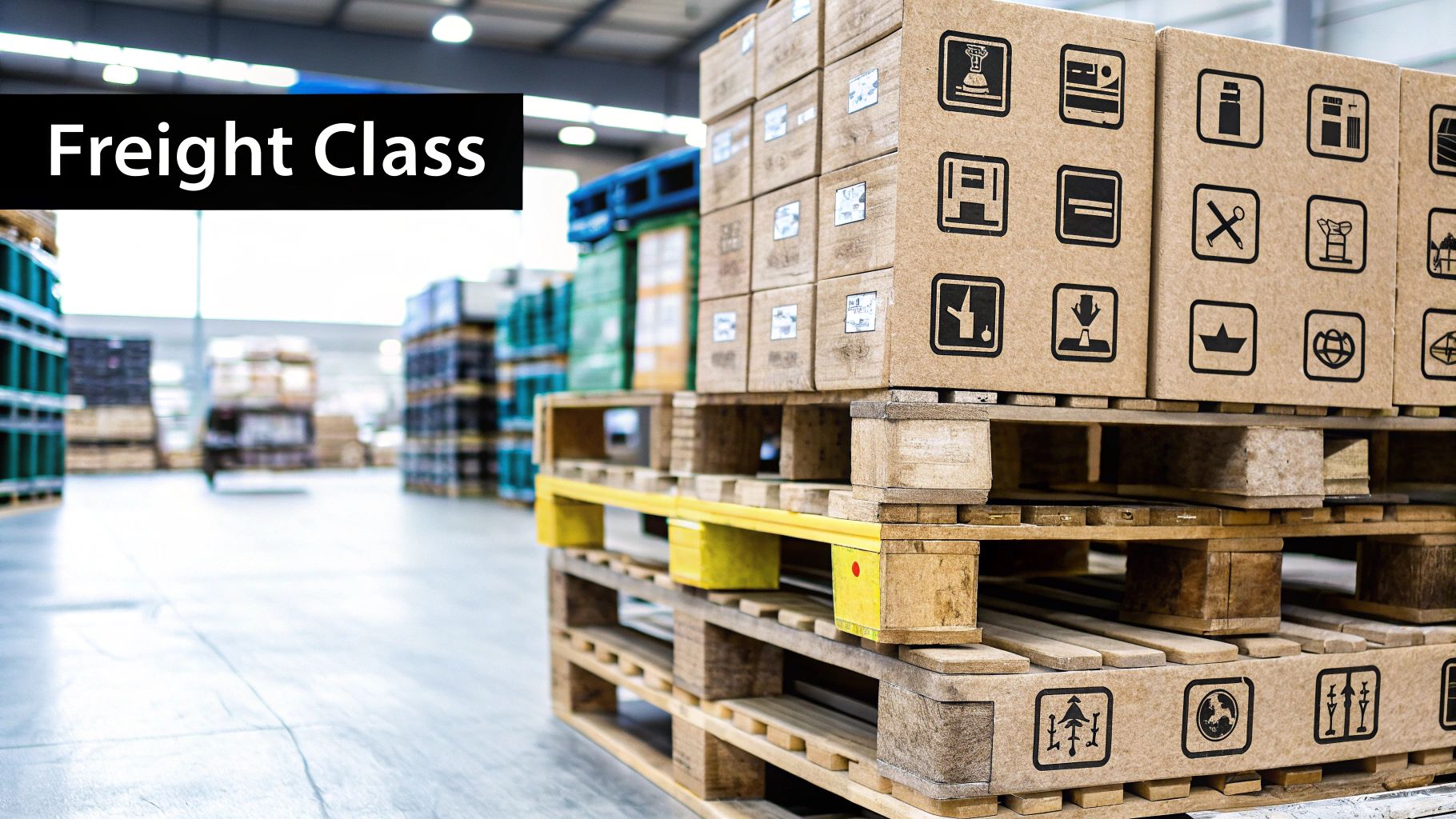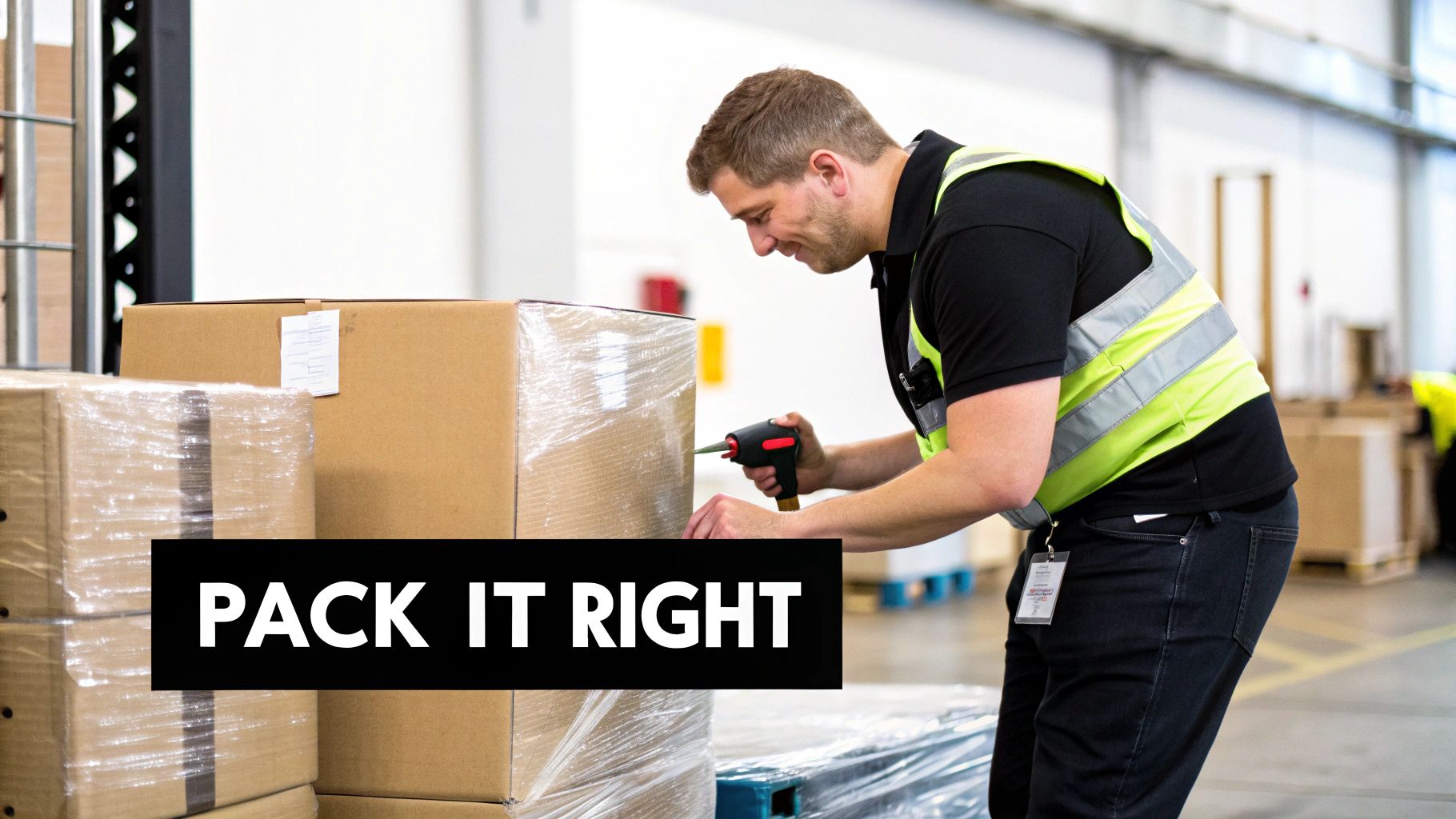what is ltl carrier? Learn how it works, key benefits, and how it can save your business on freight.

Ever find yourself needing to ship something that's way too big for a parcel service, but not nearly enough to fill an entire semi-truck? This is the sweet spot where LTL (Less-Than-Truckload) carriers come into play.
Think of an LTL carrier as a kind of rideshare for your freight. Instead of you footing the bill for a whole truck, your shipment hitches a ride with others, sharing both the space and the cost. It's an incredibly efficient way to move goods across the country.
This "shared space" model is perfect for shipments that typically weigh between 150 and 15,000 pounds. So, if booking a full truck (FTL) is like chartering a private jet, using an LTL carrier is more like buying a seat on a commercial flight. You only pay for what you use.
At its heart, LTL shipping is all about pooling resources. Carriers collect smaller shipments from multiple businesses and consolidate them onto a single truck heading in the same general direction. This simple but brilliant idea unlocks some major advantages for shippers like you.
This whole system makes professional freight shipping a realistic and affordable option, especially for small and medium-sized businesses that need to keep a close eye on their shipping budgets.
Ever wondered what really happens after your pallet gets picked up? It's not as simple as one truck driving from point A to point B. The secret sauce of LTL shipping is a clever "hub and spoke" system, which you can think of as the trucking version of an airline's flight network.
Your shipment’s journey starts when a local truck picks it up and brings it to a nearby terminal—this is the first "hub." Here, it's carefully unloaded and sorted with other pallets heading in the same general direction. This step, called consolidation, is where the cost savings really kick in.
From that local hub, your freight gets loaded onto a long-haul truck bound for a much larger regional distribution center. At this massive sorting facility, it’s unloaded again and re-sorted for the next leg of its trip. Sometimes, this means it will travel to yet another regional hub before it gets close to its final stop.
This infographic breaks down the core journey from start to finish.

As you can see, the LTL carrier is the coordinator of this whole dance, managing every handoff between the shipper and the final receiver.
Once your shipment arrives at the local terminal closest to its destination, the process reverses. It gets loaded onto a smaller, local delivery truck for the final "spoke" of its journey—the last mile to the receiver's doorstep. It's this multi-step handling and sorting process that makes LTL shipping so efficient for smaller freight volumes.
The entire operational flow of LTL shipping is also heavily influenced by modern regulations, like the Electronic Logging Device (ELD) mandates. These rules impact everything from driver hours to transit schedules, ensuring safety and compliance across the network.
And this network is always growing. Just look at major carriers like Saia, which recently opened 21 new terminals. This expansion helped them handle a 12.2% year-over-year increase in tonnage, proving just how robust and vital the LTL system is. It’s a clear sign of the industry's strength and ability to adapt.
Ready to put this powerful system to work for your own freight?
So, you have freight to move. Now comes the big question: LTL or FTL? Deciding between Less-Than-Truckload (LTL) and Full Truckload (FTL) can feel like a tough call, but it really just comes down to a few simple things: how big your shipment is, what your budget looks like, and how quickly you need it to get there.
Think of LTL as a carpool for your freight. It's the perfect solution when you don't have enough cargo to fill an entire truck on your own. As a general rule, if your shipment is between 1 and 6 pallets and weighs less than 15,000 pounds, LTL is almost always the smartest, most budget-friendly way to go. Why pay for a whole truck when you only need a small slice of it?
On the flip side, Full Truckload (FTL) is your private ride. It's built for those big jobs that take up a whole semi-truck. If your shipment is tipping the scales at more than 15,000 pounds or you've got more than six pallets to move, FTL starts making a lot more financial sense.
But it’s not just about size. FTL brings some serious perks to the table. Since your freight is the only thing on board, the truck goes straight from Point A to Point B with no detours. That means your stuff gets there faster and is handled way less, which is a huge plus for delicate or high-value items. You can learn more in our complete guide to full truckload shipping.
To make it even clearer, let's break down the key differences side-by-side. This table should help you quickly spot which option is the right fit for your cargo.
By selecting the right service, you can avoid common pitfalls like overpaying for unused truck space or choosing a method that doesn't meet your delivery deadlines. The right choice depends entirely on the unique characteristics of each shipment.
Ultimately, choosing the right LTL carrier or FTL provider comes down to finding that perfect balance between cost, speed, and the safety of your goods. Picking the right one ensures your freight arrives on time and on budget.

Trying to get a handle on LTL shipping costs can feel like you're chasing a moving target. But it really boils down to one core concept: freight class.
Think of it as a universal "ID number" for whatever you’re shipping. The National Motor Freight Classification (NMFC) created this system to standardize pricing across the board, making it fair for everyone. Every item gets assigned a class number, ranging from 50 to 500.
It's pretty simple: the lower the class number, the cheaper it is to ship. The higher the number, the more it will cost. Your LTL carrier uses this class as the starting point to calculate your rate.
Curious what your freight will cost? Let's find out.
So, how does the system come up with that all-important class number? It’s not random. The calculation is based on four key characteristics of your freight. Getting these details right is the first step to getting an accurate quote.
Density: This is the big one. It's all about how much space your shipment takes up compared to its weight. Items with low density (think a pallet of ping pong balls) get a higher class, while high-density items (like a pallet of steel bolts) get a lower class.
Stowability: How nicely does your freight play with others? Awkwardly shaped, oversized, or hazardous goods are tougher to load and fit into a trailer, so they get a higher freight class.
Handling: Does your shipment need any special treatment or equipment? Freight that's fragile, heavy, or requires extra care during loading and unloading will land in a higher class.
Liability: This factor weighs the value of your goods and the risk of theft or damage. High-value or delicate items pose a bigger liability for the carrier if something goes wrong, bumping them into a higher, more expensive class.
If you really want to dig into the details, check out our guide on how to determine a freight class.
Keep in mind, the final cost isn't just about the freight class. Carriers also adjust their base rates to keep up with the market. Recently, most major LTL carriers announced general rate increases (GRIs). For example, ABF Freight rolled out a 5.9% increase and Saia implemented a 7.9% hike. This is why getting a current, all-in quote is more crucial than ever.
Sure, saving money is the big, flashy benefit everyone talks about with LTL shipping, but the real advantages are woven much deeper into your operations. If you're running a smaller business, the flexibility LTL offers can completely change how you manage your supply chain.
Think about it: you're no longer stuck waiting to accumulate enough orders to justify a full truck. You can ship out smaller batches as soon as they're ready. This means you can keep your inventory nimble, restock shelves faster, and react in real-time to what your customers are buying.
And here’s something you might not have considered: it's a greener way to ship. LTL is all about consolidation—filling one truck with freight from multiple shippers. That means fewer half-empty trucks crisscrossing the country, which directly cuts down on fuel consumption and shrinks your company's carbon footprint. It’s a win for your budget and the planet.
Beyond just moving boxes from A to B, LTL carriers offer a menu of handy accessorial services that you typically won't find with FTL. These are the little add-ons that solve big logistical headaches.
The LTL world has definitely been through some turbulence recently, with some major carriers closing up shop and shaking up the market. But things are looking up. The industry is stabilizing and even showing signs of growth, which you can read more about in the 2025 LTL industry outlook.

A little prep work goes a long way toward making sure your LTL shipment arrives safely and on budget. Your freight is going to be handled multiple times on its journey, so following best practices isn't just a friendly suggestion—it’s crucial for preventing damage and avoiding surprise fees. Think of it as your pre-flight checklist before your cargo hits the road.
The first step is always secure packaging. Whatever you do, don't let boxes hang over the pallet's edge. That’s a surefire way to get your items damaged and can even lead to costly re-measurement fees. Your goods need to be packed tightly and shrink-wrapped to the pallet, creating a solid, stable block that can handle the ride.
Once everything is packed up, getting your paperwork and measurements right is absolutely critical. Even small mistakes can bring your shipment to a screeching halt or leave you with expensive billing adjustments from the carrier.
Taking a few extra minutes to double-check every detail is the best way to protect your bottom line. A seemingly small mistake in weight or dimensions can lead to reclassification charges, wiping out any savings you thought you had.
For a deeper dive into the nuts and bolts, our guide on how to ship freight has even more great tips. Working with a trusted freight service also gives you a huge advantage, letting you compare quotes from different carriers to make sure you get the best rate and service every single time.
Even after you get the hang of LTL shipping, a few questions always seem to come up. Let's tackle some of the most common ones we hear from shippers just like you.
Think of it this way: the LTL carrier is the company with the actual trucks on the road, the drivers, and the terminals. They’re the ones physically moving your freight from A to B. Companies like FedEx Freight or Old Dominion are perfect examples.
A freight broker, on the other hand, is your logistics matchmaker. Instead of owning the trucks, they have a huge network of carriers they work with. A good broker does the heavy lifting for you, finding the best carrier for your specific load, route, and budget. It saves you the headache of calling around for quotes and vetting companies yourself.
Ready to see what a top-notch network can do for your rates?
Getting your shipment’s density right is a crucial step because it helps determine your freight class, which directly impacts your cost. It sounds complicated, but it's just a simple three-step formula.
Grab a calculator and follow along:
Simple—you need a liftgate anytime the pickup or delivery spot doesn't have a loading dock or a forklift. This is almost always the case for residential deliveries, but it also applies to businesses like strip mall storefronts or construction sites.
Forgetting to add a liftgate when it’s needed is one of the most common ways shippers get hit with unexpected fees, so always double-check the locations